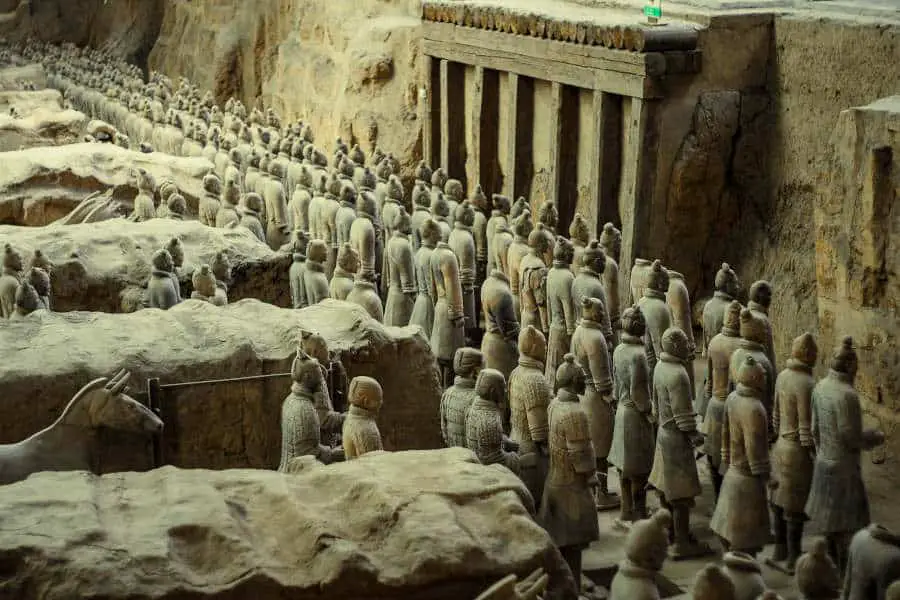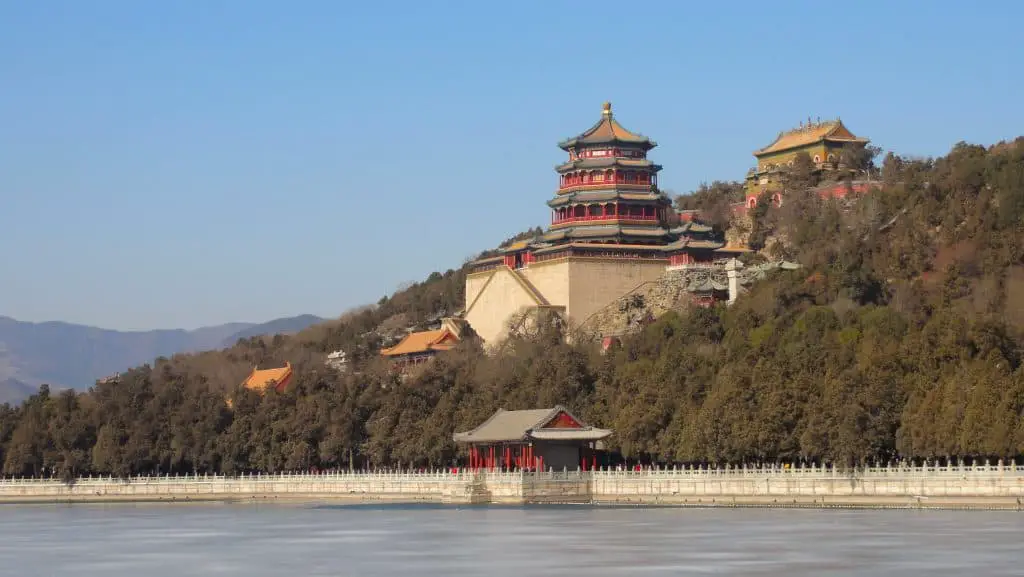With its thousands of years of history and the vast size of land, China is the home of so many historical monuments, some of them are very important not only for China but for the world in general.
Here are five of the most important monuments in China, each with its own history and unique values.
The Terracotta Army
The Terracotta Army monument was discovered in 1974 near Xi’an and was part of the mausoleum of Emperor Qin Shi Huang It got the name “The Terracotta Army” due to how the complex consists of more than 7,000 terracotta figures of life-sized ancient Chinese warrior, chariots, horses, and other military figures made of a mixture of clay and soil.

The monument’s name in Chinese is 马 (bīng mǎ yǒng), which is literally translated to “soldier and horse funerary statues”. The complex also contains more than 10,000 bronze weapons and was considered and praised as the Eight Wonder of the World in September 1987 by Jacques Chirac (former president of France)
The Terracotta Army monument consists of three different vaults (or pits) and an exhibition hall of the Bronze chariot:
- Vault 1: around 230 meters by 60 meters, it is the biggest of the three pits. There are around 2,000 soldier and horse figures on display, but there are actually more than 6,000 in total in this area alone.
- Vault 2: the most famous of the three pits, being around 96 meters by 84 meters in size. This area is famous because it has the most figures of military units from soldiers to archers to chariots and cavalry soldiers.
- Vault 3: the smallest (21 m x 17 m) with only 68 terracotta figures, but all of them are officials. This area represents the command post.
- Bronze Chariots Exhibition Hall: the area contains the intricate bronze chariots, each of them is very complex with over 3,400 parts weighing 2,720 lbs (1,234 kgs).
History
The Terracotta Army was built by Emperor Qin Shi Huang, China’s very first emperor. The construction of the complex began in 246 BC just when he (aged just 13) ascended the throne. The terracotta figures were prepared as an afterlife army for Emperor Qin, according to the ancient Chinese belief that objects like statues can be animated in the afterlife.
An interesting feat of this complex is that tall the terracotta figures were made to face east towards Emperor Qin’s enemies back in the Warring States period.
The Summer Palace
The Summer Palace is widely known as China’s largest existing imperial garden. In 1998, UNESCO added this complex to the World Heritage list. Being over 300-hectare in size (around 740 acres, it is one of the biggest and the most captivating landscape garden designs not only in China but all around the world.
The complex combines artificial architectures from pavilions, palaces, temples, and bridges, with beautiful natural landscapes of hills and open water.

The Summer Palace is located in northwest Beijing and is believed to be the most preserved imperial garden in the world. It is only a short drive away (around 9.3 miles/15kms) from central Beijing, but the 1.1 square miles (2.9 sq km) area is very different compared to the metropolis Beijing.
Tourists can enjoy various activities in the Summer Palace Complex, from walking the famous Long Corridor, boating on Kunming Lake, and various traditional performance in the ancient theater.
The Summer Palace was designed with the purpose of achieving harmony with nature. It harmonizes plants and architecture paths, water and land, and emphasizing the philosophy of Chinese garden landscapes in general.
History
The Summer Palace was commissioned by Emperor Qianlong of the Qing Dynasty in 1750. The first Summer Palace was named Qingyi Yuan or “the Garden of Clear Ripples”.
However, this original Summer Palace was destroyed by the Anglo-French Allied Forces back in 1860 and was rebuilt in 1896. It was destroyed again in 1900 and was rebuilt in 1912 as the final acts of the Qing Dynasty, and in 1924 it was officially opened to the public as a tourist attraction.
Related reading: “Top 5 Amazing Natural Places in China“
The Longmen Grottoes
Located in Luoyang, the Longmen Grottoes (or Longmen Caves), is one of China’s most famous grottoes together with three other caves (Majishan Grottoes, Yungang Grottoes, and Mogao Grottoes).

Similar to the Summer Palace, the Longmen Grottoes is built in a very impressive natural environment. Some of the caves were carved from natural limestone caves, and house tens of thousands of Buddha statues, tablets, and rock reliefs.
It is located in Mount Xiangshan to the east and Mount Longmen to the west (hence the name), separated with the Yi River that flows between them. There are thousands of niches carved in these caves in various shapes and hundreds of fine calligraphy inscriptions (mainly in Northern Wei style).
The largest grotto of the Longmen Grottoes is the Fengxian Temple. The 30 meters wide and high cave which houses some of the most impressive statues and sculptures in this Grottoes.
The carvings found in Fengxian Temple are widely regarded as the best, most perfect Tang Dynasty architecture. Fengxian temple fully represents the characteristics of the Tang Dynasty with its Buddha statues.
History
Longmen Grottoes was built in 493 CE during the Northern Wei Dynasty (386-534 CE). Emperor Xiaowen moved his capital from Datong to Luoyang and constructed these caves during the rise of Buddhism in China.
The construction of the Longmen Grottoes continued in the Tang Dynasty (between 618-907), but many statues were destroyed during the Sino-Japanse War (1937-1845).
Longmen Grottoes was declared as one of the first tourist zones to be protected at the state level in 1982, and in 2002 was added to UNESCO’s World Heritage list.
Related reading: “Top 5 Famous Chinese Temples You Must Visit“
Dunhuang Crescent Moon Spring
The Crescent Moon Spring is located in Dunhuang, to be exact at the foot of Mingsha Mountain, surrounded by sand dunes. From far and from the air, the Crescent Moon Spring resembles a crescent moon, hence the name.
The Crescent Moon Spring is an area with lush vegetation sustained by the spring water and is a functioning oasis in the desert.

Laika ac from Wikimedia Commons (CC BY-SA 2.0)
It was originally a natural phenomenon, but various buildings were built in a neat order to the south of the Crescent Spring, including the Palace of Bodhisattva, the Palace of the Dragon King, the Palace of the Heavenly Queen Mother, and more. Hundreds of statues and paintings are located in these major palaces.
The Crescent Moon Spring is 33 feet (100 meters) long from north to south and 82 feet (25 meters) wide from east to west. It is deeper on the east side, being five meters deep at the deepest part.
Another interesting feature of the Crescent Spring is how the peaks of the Mingsha Mountain make a sound as the wind blows during the sunny days. What caused the phenomenon is still the subject of various researches until this day, but many believe it is caused by resonance.
History
According to legends, during the Western Han Dynasty (206 BC to 9 CE), Emperor Wu obtained a mythical, divine horse near the Crescent Spring area (back then, the Wowa Pond). Emperor Wu then ordered to build a stele in memory of this event at the exact location of the Crescent Moon Spring. We can still see this stele today that reads “Wowa Pond of the Han Dynasty”.
During the time of the Tang Dynasty (618-907 CE), buildings were distributed in a neat order to the south of the Crescent Spring.
🧧 Use our free “ChinaGoGuide” app. Your personal guide to your journey to China. Try it now!
Kaifeng
Kaifeng was the most important metropolis not only in China but in the world at the peak of its glory and is famous for being one of the most important ancient capitals in China.

Kaifeng is located around 72 km from Zhengzhou, in the East of Henan Province with an area of 2,488 square miles (6,444 sq km). It is located just south of the Yellow River, facing the Huanghuai plain to its south. There are many attractions to explore in Kaifeng, including:
- The Iron Tower of Kaifeng, a 13-story, 183 feet (55.88 meters) tower, is known as the first iron tower in the world (built in 1049)
- The Garden of Qingming Riverside Landscape, is a large garden from the Northern Song Dynasty (960-1127 CE).
- Greater Xiangguo Temple, a Buddhist temple from the times of the North Qi Dynasty (550-577 CE).
Kaifeng is also famous for its chrysanthemum, and the Chrysanthemum Flower Fair has been famous since the 900s. The Chrysanthemum Flower Fair is still held every year in October/November, showcasing thousands of different types of Chrysanthemum.
History
Kaifeng, at its glory, was the capital of the Northern Song Dynasty between 960 and 1127 CE. As mentioned, it was the most important and the most prosperous metropolis in the world, and also the home of many historical figures from the national hero Yue Fei to the famous Bao Zheng.
Kaifeng is the home of Chinese calligraphy and the Henan Opera, the home of four famous calligraphy schools (Huang Tingjian Calligraphy School, Sushi Calligraphy School, Cai Xiang Calligraphy School, and Mi Fu Calligraphy School ),
An Introduction to Chinese History & Culture (Aff.link)
Dive into China’s rich past and intriguing present! From ancient dynasties to modern powerhouses, uncover Chinese culture facts, pivotal moments, and the captivating tales that have shaped this vast nation.
Stay in Touch
 Join our newsletter by using the forms on this website or click here!
Join our newsletter by using the forms on this website or click here! Follow us on Google News
Follow us on Google News Follow us on Facebook
Follow us on Facebook
Featured image by Peter K Burian from Wikimedia Commons (CC BY 4.0)






